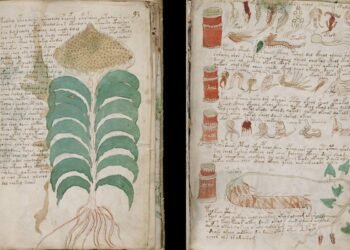A joint Egyptian-Spanish archaeological mission, spearheaded by the University of Barcelona and the Institute of Ancient Near Eastern Studies, has made remarkable finds from the Ptolemaic era in the Al-Bahnasa archaeological site, located in Egypt’s Minya governorate. The mission uncovered tombs along with exceptional mummies and burial artifacts.
Dr. Mohamed Ismail Khaled, Secretary-General of the Supreme Council of Antiquities, described the findings as “a major addition to the history of the region,” emphasizing their uniqueness to the Al-Bahnasa area.
Among the most remarkable discoveries are 13 golden tongues associated with mummies—a first for this region—and golden nails, which symbolize preparation for the afterlife. These artifacts, along with inscriptions and elaborate burial customs, provide valuable insights into Ptolemaic religious beliefs.
The team uncovered a series of tombs decorated with colorful inscriptions and ritual scenes. One tomb, accessed through a rectangular stone burial shaft, featured a central hall with three chambers. According to Dr. Esther Pons Mellado, the Spanish mission leader, these chambers contained dozens of mummies, arranged meticulously, suggesting communal burial practices. Another burial shaft led to similarly decorated chambers, one of which belonged to an individual identified as “Wen Nefer.”
This tomb stands out for its intricate wall paintings depicting Wen Nefer and his family presenting offerings to deities such as Anubis, Osiris, Atum, Horus, and Thoth. The ceiling showcases the goddess Nut, surrounded by stars and sacred boats carrying deities like Khepri and Ra, against a striking blue background. One mummy within the chamber was covered in a delicate layer of gold, symbolizing divine protection. The tomb also housed four limestone sarcophagi.
Dr. Hassan Ibrahim Amer, excavation director and professor at Cairo University, highlighted the discovery of a heart scarab in situ, a rare find in Egyptian archaeology. Alongside it, 29 amulets were uncovered, including djed pillar amulets, scarabs of Horus, Thoth, and Isis, and composite amulets combining the attributes of these gods. These artifacts, rich in symbolism, underline the syncretism of Ptolemaic religious practices. The mission also unearthed terracotta figurines, including one of the god Harpocrates.
Al-Bahnasa, historically known as Oxyrhynchus, has been the site of previous excavations uncovering tombs from the Saite, Greco-Roman, and Roman periods, as well as a Byzantine basilica and a temple dedicated to Osiris. In addition to Ptolemaic discoveries, the team resumed work at the Coptic Monastery of Saint Cyriacus, a Christian basilica dating back to the 5th-7th centuries CE.
The findings at Al-Bahnasa underscore the complexity and richness of ancient Egyptian funerary and religious practices. As Dr. Khaled noted, “This discovery offers a unique window into the cultural and spiritual practices of the Ptolemaic period.”






















